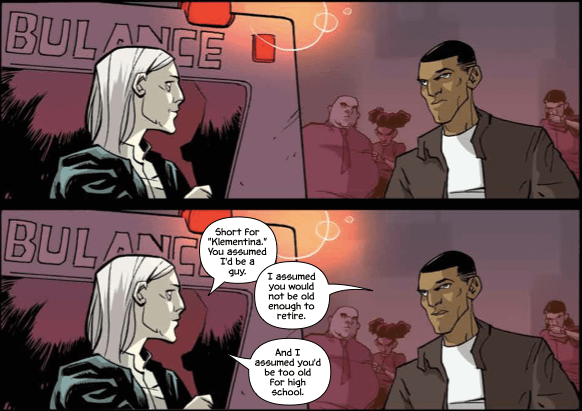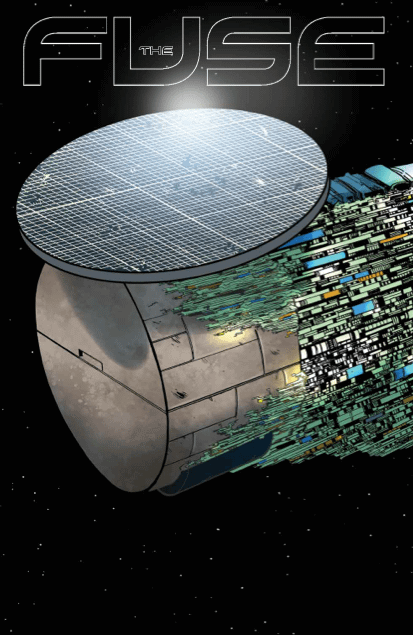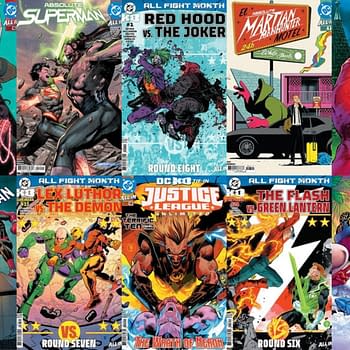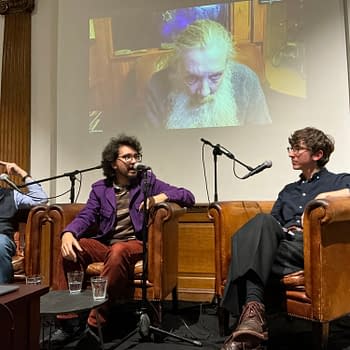Posted in: Comics, Recent Updates | Tagged: antony johnston, Comics, Ed Brisson, entertainment, image comics, justin greenwood, shar Chankhamma, the fuse
Image's The Fuse Arrives And It's A Sci-Fi Cop Trend Breaker – The Bleeding Cool Interview With Antony Johnston
The Fuse launches this week from Image Comics, and a first glance at it on the shelves is going to inspire readers to take a closer look, and if you are one of those readers, you will most likely thank your lucky stars that you did. It has one of *those* covers that's an excellent melding of design elements that we've come to expect from Image books lately, and it manages to convey some of the energy and mystery that the book contains quite well, even hinting at how big a universe will eventually be revealed as the arc gathers steam.
But jumping into the first issue has many surprises in store because this sci-fi cop story, already an unusual combination of genres, just doesn't read like any other comic on the market right now. It's funny, highly readable, relentlessly matter-of-fact in its storytelling, iconoclastic in its character choices, and remarkably stream-lined and approachable in its artwork. Yet it handles two genres that are more often than not rather dark and gritty in their tone and often over-burdened in detail, dialogue, and explanation, particularly in a first issue. The Fuse seems to bypass all those pitfalls in an effortless way and when you're done reading the comic, then you ask yourself, "How on earth did they manage to do that?"
Writer Antony Johnston and artist Justin Greenwood seem at first to have a degree of creative chemistry that's precocious, but investigation reveals that previous extensive collaboration on Oni Press's The Wasteland paved the way for this page-by-page tandem narrative that's seamless in its goals and execution. Colors by Shari Chankhamma and letters by Ed Brisson seem equally well synched. Then there's the passion that Johnston is bringing to the work with an idea he's had for some time, but held off on pursuing because he feared that two of his favorite genres, sci-fi and cop stories, wouldn't be appealing to readers. Thankfully for us, he finally bit the bullet and threw caution to the wind to create the world of The Fuse.
Antony Johnston discusses the new comic here with us at Bleeding Cool.
Hannah Means-Shannon: Firstly, the cover design for the comic and the logo itself are just fantastic. How do you think they capture the spirit of the comic?
Antony Johnston: Thank you! Hopefully the logo and #1 cover serve two purposes.
First, they're informative in a literally iconic way; it's sci-fi, it takes place in orbit, there's a space station, someone's gonna get shot. All of that comes across simply from the graphic cover elements and style of the logo.
But in addition to that, I wanted to use the colors and clean design to set expectations of style and mood. It would have been very easy to go with a dark cover, all grim cops moodily pointing their guns and looking constipated, and so on. Which is fine, but then readers would naturally expect some kind of grim 'n' gritty noir, and that's not what The Fuse is. It's "dirty sci-fi", downtrodden and cynical, sure. But at its heart this is a detective book, a murder mystery, a crime procedural.
There's also a practical consideration; in this age of Comixology, iPads, and online stores, it's important that the cover and logo still have an impact when shrunk down to a small size on-screen. The Fuse #1 design definitely does that.
HMS: So as you say in the back of issue #1, this is a mash-up extravaganza as well as a comic containing stuff you "fucking love". Was this just a breaking point for you where you decided to write about everything you haven't manage to get into writing about your favorite genres until now?
AJ: Well, the funny thing is that I've been planning The Fuse for a long time, now. More than ten years, in fact, and many elements were originally different — different station design, different characters, different motivation. It was still a murder mystery, but the focus wasn't on the cops. And it wasn't working… until I realized the cops' story was what I really wanted to write. That was about ten years ago.
So it wouldn't be right to say those were things I hadn't managed to get into my writing at the time. After all, ten years ago I'd only published half a dozen books and comics.
But! I didn't do anything with it. Mainly for the reasons I talk about in the issue #1 text piece — the prevailing wisdom has always been that cop comics don't sell, sci-fi comics don't sell. So I thought, what's the point if nobody else wants to read it? I write for me and my own tastes, sure, but I'm not completely stupid.
But The Fuse wouldn't go away, wouldn't lie down and leave me alone. It was always in the back of my mind, nagging away. OK, so maybe nobody else would want to read it. But I really, *really* wanted to write it.
I actually became angry at myself for listening to those people, and not going for it. After all, I've spent most of my career following my gut. It doesn't always work, it's not always popular, but I don't regret any of it for a moment. I'd always rather try something new, and risk failure, than not bother trying just because it might not work.
So that's why it's a mashup of things I love, but haven't done before — because they're things everyone kept telling me wouldn't sell. And the irony, wouldntyaknowit, is that it's probably the most-anticipated thing I've ever done. When it was revealed, it became clear that people loved the concept.
HMS: What is it about the two-person cop team-up that is just endlessly entertaining? What exactly do you think is the appeal of that to you as a reader/viewer and as a writer?
AJ: It's not just cops; I think the two-person team-up works well for almost any kind of plot-driven drama. Characters need someone else to bounce off, to talk to, to argue with, to help figure things out and drive the plot forward. Hell, we need them as writers to help explain things to the audience.
With a solo character, stories become very different, as do the methods required to tell them. I've done books filled with internal-monologue captions, and there's nothing wrong with that method, but it makes for a very different story to what I wanted for The Fuse.
So you need more than one character, but keeping it to two means you can play off contrasts while still making everything as lean and efficient as possible.
And that works for the audience, too. No wasted characters, no wasted lines, no wasted attention. Everyone else is merely a supporting character. *These* are the people you should be watching. These are the binary stars around which this system revolves.
HMS: You really went for the least predictable character duo possible here—an older, tough as hell Russian female cop and a young, attractive African-German guy. Was that designed to make sparks fly? How on earth did you decide on those characters?
AJ: I always knew I wanted the lead to be old enough that they should have retired, and the new cop to be a young wunderkind. I figured, if you're going to have the veteran/rookie dynamic, why not really push it to extremes? Besides, we just don't see that many genuinely old lead characters in comics…
…Especially women. That's what set me off thinking about making the lead cop a woman. And if you do that, if you reverse the "norm" of that role's archetype, well then it only feels right to reverse the young cop's archetype, too.
So yes, there's a certain amount of wanting to screw with people's expectations. I use Ralph's own reaction to Klem to highlight that.
But the more I delved into them, especially knowing how I wanted these characters to develop, it felt more and more like the right thing to do for the story, too. There's more to both Klem and Ralph than meets the eye, and we'll see that throughout the course of the series.
HMS: What are the problems of setting a cop story in space? I notice you carefully discussed the issues of firing a gun and pressure problems. What else did you have to give some serious thought to in order to make the combination work?
AJ: Oh, I have a big old world bible I've been building ever since I started work on The Fuse. Guns, hull damage, orbital mechanics, citizenship, economy, media, elections, social division, transport, energy collection, storage and transfer… honestly, the issue of "cops in space" was probably the easiest part to deal with.
Besides their reduced staff levels, there's not much to separate the Midway City PD from modern cops. Sure, they have slightly advanced tech like global database access, always-online tablets and scanners, voip headsets, plastic bullet firearms, all of that. But that stuff only enables them to do their job more quickly; it can't actually do the job for them.
Murder is murder is murder, and the essentials of the job don't change. A detective still needs to question people, sort the truth from the lies, figure out what really happened and why.
That said, I had one such "but we're in space!" moment the other day while writing a scene. I suddenly had to stop and think, would there be cop cars on the Fuse? I concluded in the end that yes, there would; maglev, of course, but you still need a way to transport suspects around, and saddling them on the back of an electric scooter isn't going to cut it…!
HMS: Ok, I'm going to go there. Though it's very humorous, I wonder if there are deeper ideas at play in having main character Deitrich made fun of for being both youthful and good-looking in terms that we might associate with sexist remarks in male environments (like the police force and cop shows) toward women in the past, and by an older female. Are you pointing out how demeaning it sounds when you apply it to another gender? Or is it just blanket hazing of the rookie as a typical cop story thing? Maybe I'm overthinking this…
AJ: You're not overthinking it at all. And I'll note that you're the first person to comment on that; isn't it interesting how it took a woman to even notice what was happening, there?
HMS: What do you most want the world of The Fuse to "feel" like for the reader. How did you try to accomplish that through your writing?
AJ: More than anything, I want it to feel real. I want Midway City to feel like a place you could visit, and walk around, and you'd understand it. It has sidewalks, it has a city hall, it has 7-11s and homeless people and local news and a park that you don't walk through at night.
Sure, the park is astroturf, and the vehicles are all maglev, and when you look up you see ceiling instead of sky. You might go down to Earthlight on Level 44, and sit in the zero-g viewing chamber, and look out the mile-long viewing port to watch planet earth slowly spinning beneath you. That would be amazing, right?
But you'd get used to it. To all of it. It's still a city, and cities are basically the same all over the world. Or in space.
(How do I try to accomplish that? With characters who talk and act like real people, and don't stop to explain every sci-fi concept in the story. When you switch on your car's ignition, you don't turn to the passenger and explain what a car is, how the engine works, and why you turned that key, do you?)
HMS: How'd you get together on this to create the comic with Justin Greenwood? What do you think he particularly brings to the table in his artwork on The Fuse?
AJ: Justin and I have been working together for a few years now on Wasteland, my post-apocalyptic epic at Oni Press. We've made something like 300 pages of comics together on that book, and I knew that when his time there was done, I'd want to work with him again on something else. The Fuse turned out to be that something.
What Justin brings is a combination of energy, great storytelling, and thoughtful design. Hell, we spent the best part of 2 hours just designing the MCPD badge. And his style is completely unique, which I'm always a big fan of. You could never mistake Justin's art for anyone else.
Finally, he's a joy to work with. Always focused on the story, always reliable, always enthusiastic.
HMS: Anything you can tease and let us do our own detective work about what's coming up in the comic?
AJ: I don't want to give too much away. Like I say, there's more to both Klem and Ralph than meets the eye, and that will play out over the course of the series. Ralph's story, in particular, will develop throughout in the background.
We'll get to see a lot more of Midway's culture, and how things work up there; we'll meet many new people, and some of them will die; we'll even introduce a new sport, something that could only take place on the Fuse.
And it's inevitable we'll visit the colonies on Mars and the Moon, sooner or later. Who doesn't want to go to Mars?
Hannah Means-Shannon is EIC at Bleeding Cool and @hannahmenzies on Twitter



















